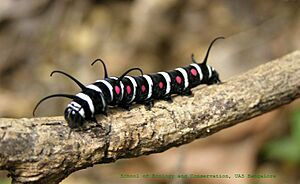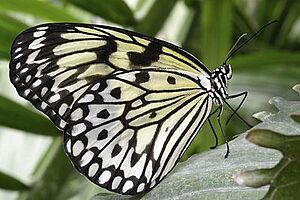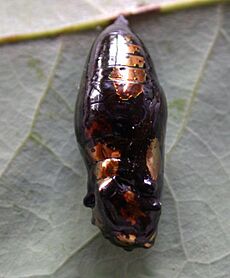Malabar tree-nymph facts for kids
Quick facts for kids Malabar tree-nymph |
|
|---|---|
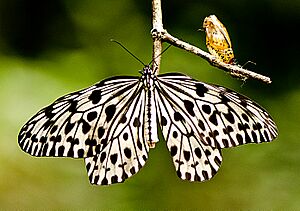 |
|
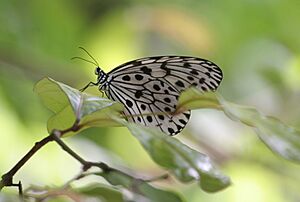 |
|
| Conservation status | |
| Scientific classification |
The Malabar tree nymph (Idea malabarica) is a very large and beautiful butterfly. It lives in the forests of peninsular India, especially in the Western Ghats. This butterfly is part of a group called "danaids" and belongs to the Nymphalidae family, also known as brush-footed butterflies. You can often spot them flying slowly in forest clearings or even high above the trees.
Contents
What Does It Look Like?
The Malabar tree nymph is a big butterfly, with a wingspan of about 120 to 154 millimeters. That's like the length of a large smartphone! It looks mostly white with black patterns. Its wings are a bit see-through.
On its upper side, the wings are a clear white, sometimes with a light dusting of black scales. The front wings have black marks like thin lines along the veins. There are also large spots near the base and a big oval spot in the middle. The outer part of the wing has three rows of black spots.
The hindwings have similar patterns. Its antennae are black, and its head and body have black streaks and spots. Its belly is white with a wide, dark black stripe on top.
A smaller version of this butterfly, called kanarensis, has been found in areas like Konkan and North Kanara.
In December 2021, the Malabar tree nymph was chosen as the state butterfly of Goa, India.
Where Does It Live?
This butterfly is found in South India, mainly in the Western Ghats mountain range. It is unique to this region. While you might see it in southern Maharashtra, its main home starts from Goa and goes further south.
How Does It Behave?
Malabar tree nymphs have a very slow, gentle, and fluttery way of flying. They often glide a lot, which is why they are sometimes called "paperkites." They usually glide high above the trees. But sometimes, they come down into open areas in the forest. Like some other butterflies in the Danainae group, they don't taste good to predators. This helps protect them from being eaten.
Life Cycle and Food
The young butterflies, called larvae or caterpillars, eat leaves from certain plants. They are known to feed on a plant called Aganosma cymosa. Another plant, Parsonsia spiralis (which is now known as Parsonsia alboflavescens), is also a food source for the larvae. Scientists believe there might be even more plants in the same family that these caterpillars enjoy eating.
Images for kids
-
Malabar tree nymph, Udupi, India
See also
- Danainae
- Nymphalidae
- List of butterflies of India
- List of butterflies of India (Nymphalidae)



